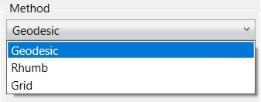Calculating Forward in Interactive Conversions
A Forward calculation is used to compute a new coordinate that is a given distance
and azimuth away from a starting coordinate. The conversion will
be calculated using either Geodesic![]() Geodesic distance is the shortest possible line between two points on the surface of the datum. This is also referred to as Great Circle distance.
It is the shortest distance between two points along the surface of the ellipsoid. (Great Circle), Rhumb Line
Geodesic distance is the shortest possible line between two points on the surface of the datum. This is also referred to as Great Circle distance.
It is the shortest distance between two points along the surface of the ellipsoid. (Great Circle), Rhumb Line![]() A Rhumb Line is a line of constant bearing. Rhumb line distance measures the distance between two points maintaining a line of constant bearing relative to true north.
Rhumb Lines are frequently used to plot navigation lines. (Constant
Azimuth), orGrid
A Rhumb Line is a line of constant bearing. Rhumb line distance measures the distance between two points maintaining a line of constant bearing relative to true north.
Rhumb Lines are frequently used to plot navigation lines. (Constant
Azimuth), orGrid![]() Grid distance measures the distance following a straight line between two points in grid space.. To complete a Forward calculation, you must have:
Grid distance measures the distance following a straight line between two points in grid space.. To complete a Forward calculation, you must have:
- A starting coordinate in a known coordinate system
- A destination coordinate system (on the same Datum as the starting coordinate)
- Distance and Azimuth
ahead from the starting coordinate
Note: For both Forward and Inverse conversions, when height values are entered, the distance is scaled to a height above the ellipsoid. For more information see Height Above Ellipsoid (HAE) Calculations
To calculate a forward coordinate between any two coordinate systems on the same Datum:
-
At the top of the Interactive Job, select the Forward radio button.

-
Determine which of the two sides of the Interactive Job will be the input side.
-
Select a coordinate system for the input coordinate (starting location).
-
Use the Format button to select the display format for your input coordinates. This is very important for angular units.
-
Select a coordinate system for the output coordinate (ending location).
-
Use the Format button to select the display format for your output coordinates. This is very important for angular units.
-
Enter the input coordinate (starting location) into the appropriate Coordinate Point fields on the input side.
-
Select a method for the forward calculation: Geodesic, Rhumb, or Grid.
Note: Grid will only be available if the conversion is for a Projected system. The source and target coordinate systems must been set to the same projected system first.

-
For the Geodesic, Rhumb and Grid methods, specify the Forward azimuth and distance. You may specify different Angular and Linear units by clicking on the appropriate buttons next to each field and using the picker to choose a different unit.
-
Ensure that the Operation Direction has the calculation direction going from the input side to the output side. To control the direction of the calculation, click the either the 'Left to Right' or 'Right To Left'.

-
Click the Calculate button. The output coordinate (ending location) will be displayed on the output side of the Interactive conversions tab.